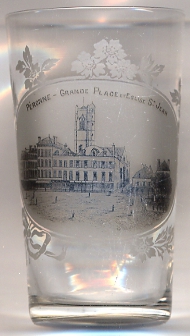

|
| FRANCE | FRANCE |
| région: Hauts-de-France | |
| département: 80, Somme |
Péronne is situated at an elevation of 54 m in the Somme valley of Northern France. It is the capital (chef-lieu) of the département of the same name in the région Hauts-de-France and the old region of Santerre, home of the early French kings. The municipality has a population of about 7,900 (2010).
On a hill, dominating the Somme river and its lakes, Péronne was a well-fortified place during the early Middle Ages. The ramparts were built in the 9th century. All that remains today of the ancient fortress is the Porte de Bretagne. Few towns have been as involved in the history of France, few towns so often devastated, as Péronne. Burned and pillaged in the time of the Normans; gravely damaged during the time of the Spanish occupation; devastated by the Germans in 1870; totally destroyed in 1917; bombarded and burned in May 1940 by the German airforce. Péronne was awarded two Croix de Guerre (1921, 1949) and the Légion d'honneur (1914).
 King Charles III (C. the Simple), prisoner of Rudolph (Raoul), Duke of Burgundy died here, a captive in the dungeons, in 929; he was buried in the abbey.
In 1468, Charles II the Bold, Duke of Burgundy forced a treaty from Louis XI, who was held prisoner in the castle. Much land was ceded, but eventually won back by Louis.
In 1536, Hoy Roman Emperor Charles V unsuccessfully besieged the town.
In 1641, Louis XIII of France and Honoré II, Prince of Monaco signed a treaty at Péronne, placing the principality of Monaco under the protection of France.
King Charles III (C. the Simple), prisoner of Rudolph (Raoul), Duke of Burgundy died here, a captive in the dungeons, in 929; he was buried in the abbey.
In 1468, Charles II the Bold, Duke of Burgundy forced a treaty from Louis XI, who was held prisoner in the castle. Much land was ceded, but eventually won back by Louis.
In 1536, Hoy Roman Emperor Charles V unsuccessfully besieged the town.
In 1641, Louis XIII of France and Honoré II, Prince of Monaco signed a treaty at Péronne, placing the principality of Monaco under the protection of France.
The  église Saint-Jean-Baptiste [background] was consecrated in 1525. Of the six churches of Péronne that existed before 1789, it is
the only one that survived. Replacing an earlier chapel, which stood here since 1101, the church was constructed between 1509 and 1525 in Gothic Flamboyant style between 1509 and 1525
as a hall church, i.e. with three naves of equal height. The bell tower was built in 1540. A mural in the chapelle du Sacré-Cœur, "La Bonne Mort", dating from 1601
has survived all destructions.
Occupied by German forces in 1914, the church was used both by the German and parochial congregations while the bell tower was used as an observation post.
The war reached the city in 1916 and by 1918 the church was reduced to ruins; only the outer walls and one vault had survived. Desite its desastrous state, the municipality
decided in 1920 to reconstruct the church. The project was started in 1925 and the church was finally consecrated again in 1932.
During World War II, when about 30% of the city of Péronne was again destoyed, the church luckily evaded major damages. Only the glass windows were destroyed in 1944
following the explosion of an ammunition carriage.
église Saint-Jean-Baptiste [background] was consecrated in 1525. Of the six churches of Péronne that existed before 1789, it is
the only one that survived. Replacing an earlier chapel, which stood here since 1101, the church was constructed between 1509 and 1525 in Gothic Flamboyant style between 1509 and 1525
as a hall church, i.e. with three naves of equal height. The bell tower was built in 1540. A mural in the chapelle du Sacré-Cœur, "La Bonne Mort", dating from 1601
has survived all destructions.
Occupied by German forces in 1914, the church was used both by the German and parochial congregations while the bell tower was used as an observation post.
The war reached the city in 1916 and by 1918 the church was reduced to ruins; only the outer walls and one vault had survived. Desite its desastrous state, the municipality
decided in 1920 to reconstruct the church. The project was started in 1925 and the church was finally consecrated again in 1932.
During World War II, when about 30% of the city of Péronne was again destoyed, the church luckily evaded major damages. Only the glass windows were destroyed in 1944
following the explosion of an ammunition carriage.
[http://en.wikipedia.org/wiki/Péronne, http://fr.wikipedia.org/wiki/Péronne, https://de.wikipedia.org/wiki/Péronne;
http://fr.wikipedia.org/wiki/Église_Saint-Jean-Baptiste_de_Péronne]
![[scale]](lineal.jpg)